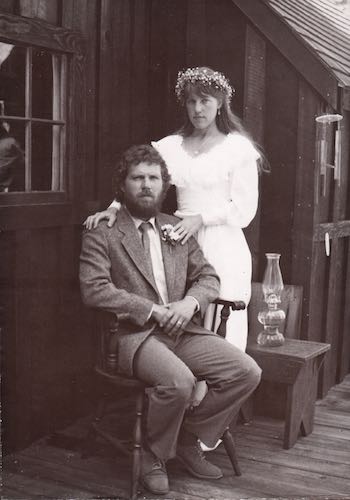
Thirty-seven Years



I enlarged these designs onto kraft paper, ordered some very large sheets of graphite transfer paper, gathered a few tools, and drove to the Three Rivers Historical Museum. My job bosses had prepped the wall for me, and they also blocked it off in a very serious manner, along with providing a ladder and a couple of tables. (They are TERRIFIC to work for!)

I had previously tested some carbon paper to see if I could transfer through the kraft paper, but had to go searching at Blick Art Materials for some large graphite sheets. There were two to choose from, and instead of accidentally ordering the wrong one, I bought both.

We measured the wall very carefully to mark the center and then figure out where the first design was to go. Then I taped the smallest design up, trying to see through the kraft paper to place it exactly on the mark I made, adjusting it until it was level.
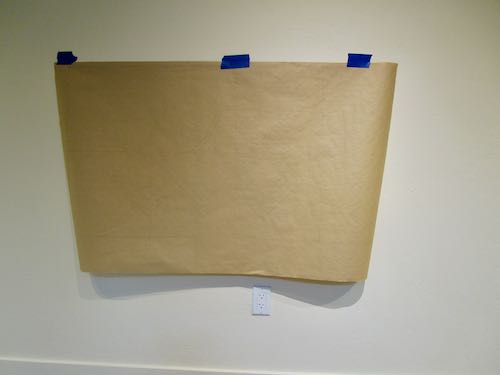
The design was drawn in pencil, so you can’t see it on this photo. I kept the bottom untaped so I could lift it up to place the graphite paper.
MASKING TAPE WOULDN’T STICK TO THE GRAPHITE PAPER!!
The museum came to the rescue with old-fashioned brown masking tape instead of the easy-removing blue type.
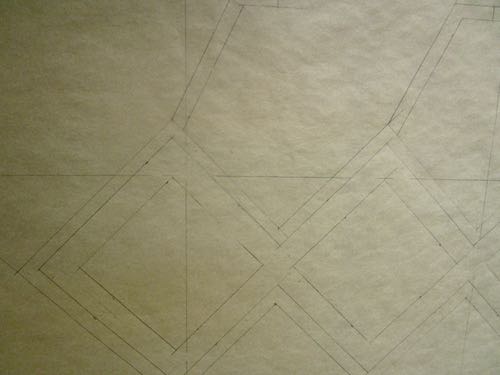
This design is called Quail, taken directly from a Yokuts basket design. I used a straight edge and traced over the pencil lines with an obsolete tool from the olden days of phototypesetting that my students and I refer to as a “spatula”. (Too hard to explain.)
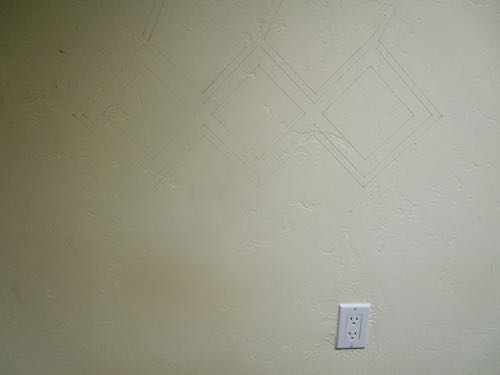
Squint hard, and you can see how it landed on the wall.
What next? I’ll show you in two days.
There is a common thread running through this month’s list. You will see what I’ve been focusing on learning lately.

2. A friend showed us these inflatable solar lights from REI. Sounds like a great way to not use propane at the cabin, but the lights themselves run from about $30-$50, depending on the size. Inflatable!?!
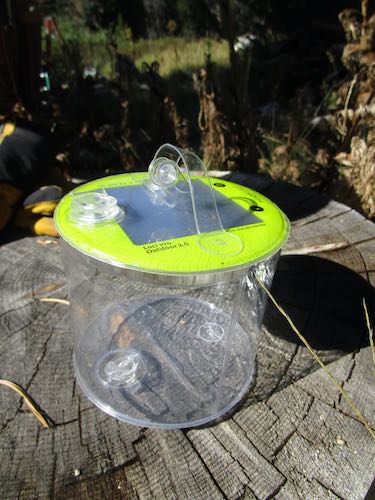

3. Glucose Revolution by Jessie Inchauspé is a book that has inspired me to change the way I eat. It is well-researched, well-written, and makes a ton of sense. Here it is on ThriftBooks (I got my copy at the library).
4. CACHE is starting a new quest to gather money to have longer hours. Their attempts to secure grants have been unsuccessful, so they will be asking 300 people to give $100/year for two years in order to be open more hours. This makes much more sense to me: the local people who care will be more involved if they feel responsible for helping to keep it running. You should see the museum now—it is fabulous, nothing like the normal small town history museums! CACHE = Center for Arts, Culture, & History, Exeter, and their website is here: CACHE
5. I learned how to transfer a pattern from a picture on the computer to a life-size outline on a wall.
6. Xylitol is a zero calorie sweetener made from the bark of birch trees. (Birch trees?? Who figured this out?) It is supposed to work on a 1:1 exchange with sugar in baking (too expensive for me!), and the reviews are mixed. Glucose Revolution says it might still spike your glucose (how?? why??); other sources say it is a great substitute without side effects. I think it tastes better than stevia (but I still prefer real sugar, so there!)
7. Monk fruit (what in the world?) is the favored non-sugar sweetener these days. I haven’t tried it yet.
8. Currants are difficult to pick, and when you run them through a juicer, they make orange goo rather than juice. If you want to make jelly, pick way way way more than you think you need, boil them awhile, then mash them in a colander for a long time to let the juice appear. Or, you can dig a hole in your garden and bury the entire mess.
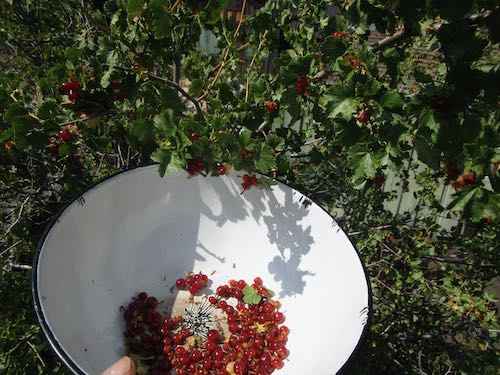
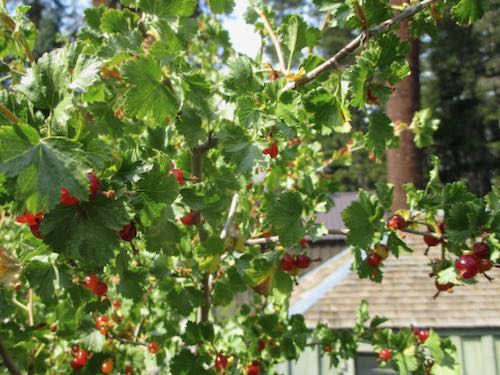

9. Did you know that buffalo are classified as bovines? I didn’t know either, until they were listed as possible subjects to enter into the current exhibit at CACHE, called “A Bovine State of Mind”.
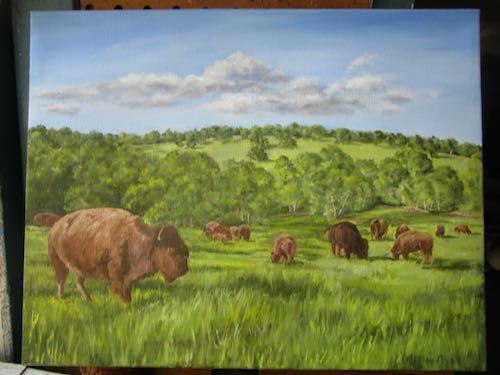
10. I heard somewhere that only 18% of Americans now attend church regularly. I’m not sure how “regularly” is actually defined here; I go native/rogue/heathen in the summer, and then attend regularly when the cabin is closed for the year. I love my church.
Nope. Some are designs, created for museum displays, by exhibit designers. The Three Rivers History Museum hired a museum designer, an exhibit designer, whatever the title is, to create a Native American exhibit, and they (or is it the Tulare County Historical Society? Or the Mineral King Preservation Society? I should pay more attention!) to execute these designs.

Every new job I take on has an entirely new set of challenges. How does one take this little PDF and turn it into a wall design? These exhibit designers may not have completely thought through the execution phase of the display. However, maybe they do know how to do such a job and just didn’t tell the museum. Maybe it involves equipment and technology that I don’t own.
No problem. I figured it out.
The designer sent it with a ?”=1′-0″ grid over the top.
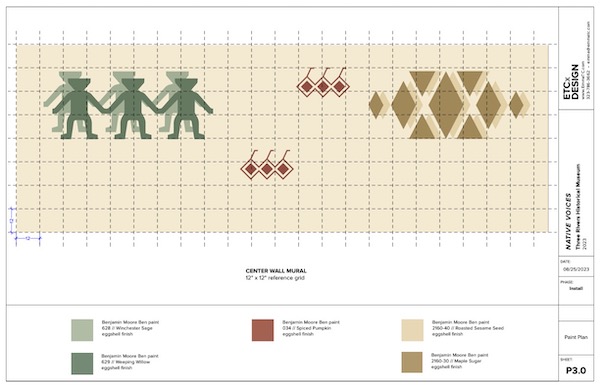
I turned it to black and white, isolated each group, and printed it. (These samples don’t show the whole designs—just wanted to give you an idea.)



Next, I got some giant kraft paper (looks like brown butcher paper on a great big roll, and if you have ever received a wrapped gift from me, you know what I’m talking about) and laid it out on my drafting table. This was quite a big jump from my normal 11×14″ pencil drawings.
And then, I started measuring and drawing.
It took an entire day.
What next? I had to figure out how to get the patterns on the wall. I’ll show you next week, after our monthly Learned List.
This is 8×8″, using a photo taken last spring somewhere on the BLM land above our house. Some people call it Case Mountain because it is below Case Mountain (mostly privately owned and gated closed). Some people call it Salt Creek because Salt Creek runs through. We call it BLM, because it is managed by the Bureau of Land Management. It used to be relatively unknown, and then along came The Google and everyone’s need to announce everything to the entire world. (STOP IT!)
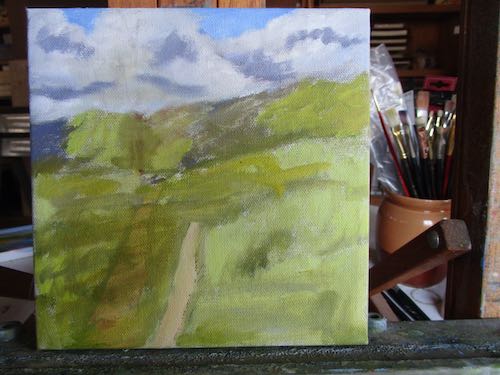




Would you believe me if I told you that it will look better when dry and scanned, and even better in person? Yeppers, it’s true.


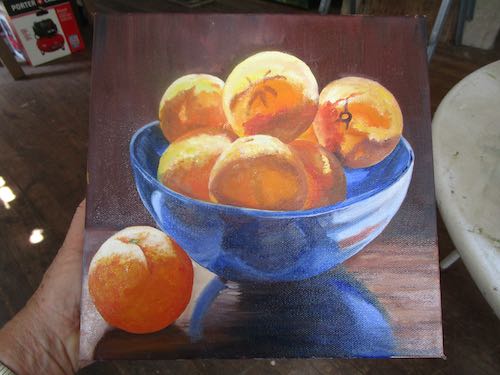
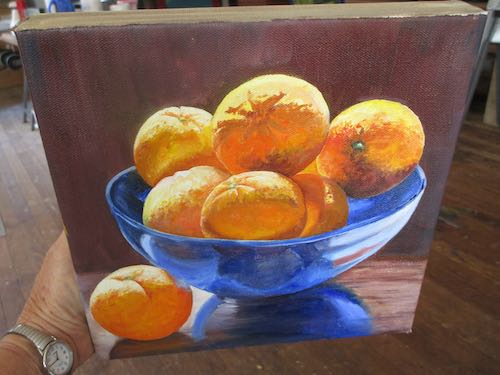
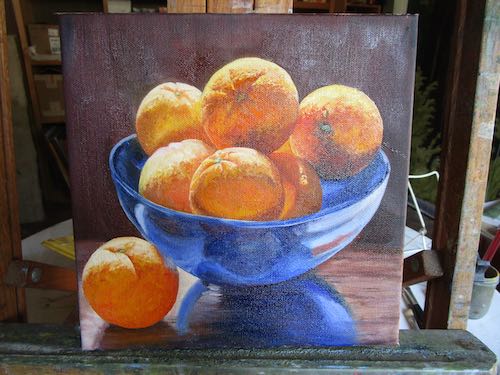
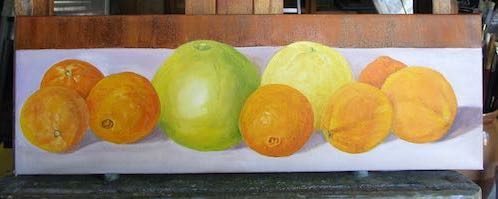

Obviously, I could use a little help with titles here.
“Oranges in a Blue Bowl” is too obvious; maybe I can think of a title that has to do with the fact that orange and blue are complementary colors. This means they are opposite one another on the color wheel—”complementary”, not “complimentary” such as “Oh my goodness, you are looking gorgeous today!”
Normally we think of ducks being in a row (WHY??), but I could call this “Citrus in a Row”. Nope, too obvious. “Citrus Variety” is boring.
Any ideas for me??
I know these aren’t just generic fruits, but the alliteration was too big of a temptation to resist.

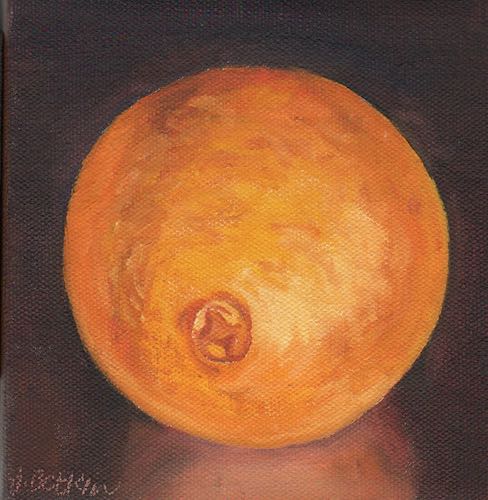
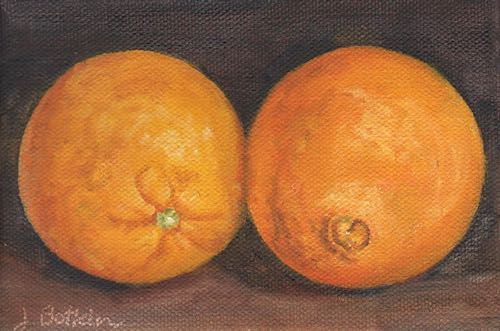
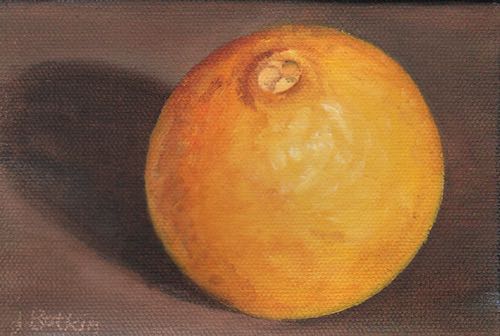
All these orange oil paintings are for sale at the Mural Gallery in Exeter, whose address might be 121 South E Street, and hours might begin at 11 a.m. but not on Tuesday, possibly not on Wednesday. Maybe you’d better call 559-592-3160 before just showing up, because clearly, I do not have solid information other than the fact that there is a boatload of great art in that tiny building.
Phew. Take a breath, Central California Artist.
These have more detail and are larger than the 4 small orange paintings I showed you last Friday.
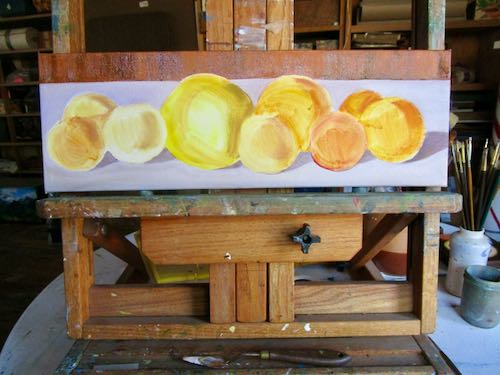
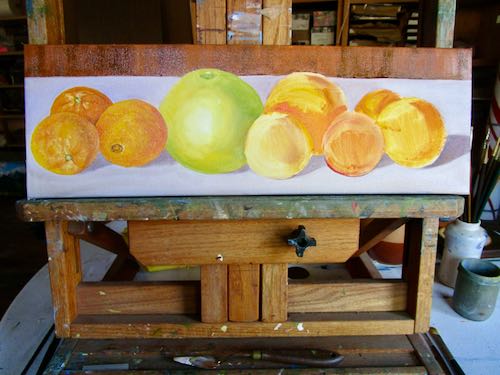

That one is almost finished. It could be considered finished, but I don’t think it is as good as it could be. I’ll need to contemplate it for awhile.
This one will require quite a bit of drawing with my paintbrushes. I like to draw with pencils, and I like to draw with my paintbrushes when they cooperate.
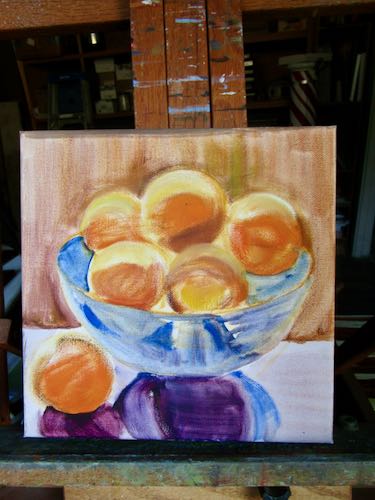
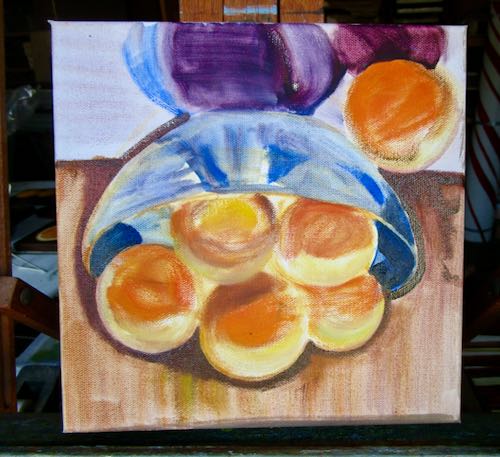
It helps to see the shapes more accurately when things are upside down. This is not an option when painting from real life. Thank goodness I am a studio painter.
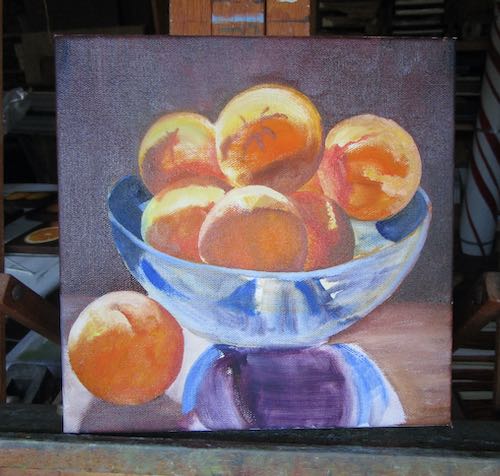
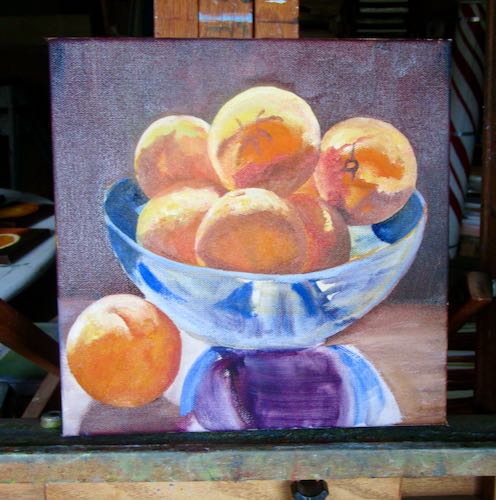
The blue bowl and its reflection will be a good challenge. I am really liking this one so far.
There are a lot of orange paintings to get done, dried, scanned, and distributed to two different places. Let’s go!


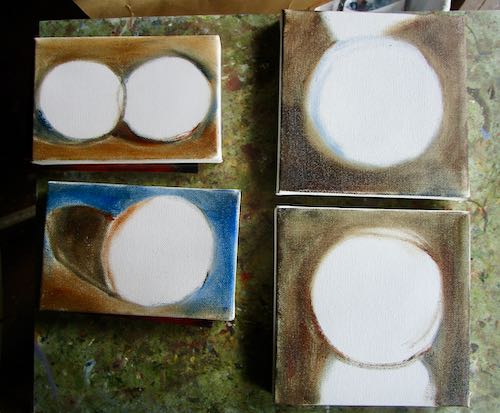
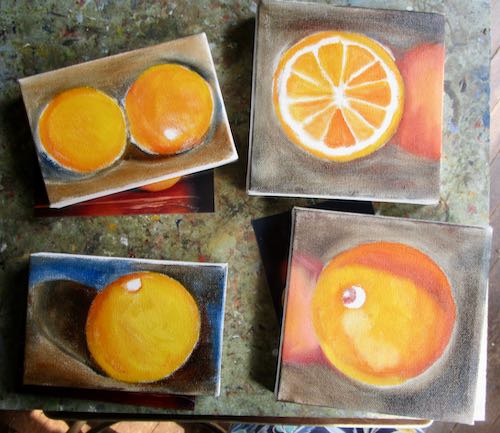

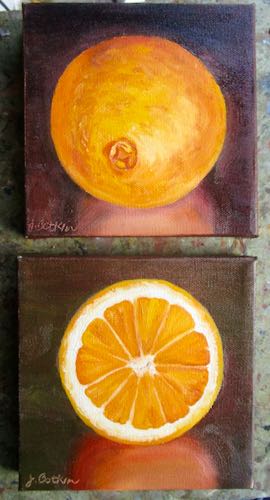
Four down, two to go.
Altogether now, “These will look better after they are dry and always look better in person”.
There is a marketing outfit for citrus, at least I think it is for marketing purposes. They have bought many pieces of orange-themed art from me through the years and are a pleasure to deal with.
Their annual banquet is coming up, and someone in the office asked me to lend them orange-themed art to decorate the lobby leading to the banquet room.
My 30+ years of experience tells me that my art won’t sell there. When the artist isn’t present and people are simply mingling, art does not sell itself. I am not invited to the banquet, and most likely I would decline the invitation. I have run out of the internal fire to schmooze and chit-chat in a loud room with the hopes of making connections that may or may not turn into work, and doing it in the town 30+ miles away at night when I am ready to park my patoot with a book and some knitting.
But this organization has been good to me, so if they want to borrow some art, my response is, “Certainly! How many pieces would you like?”
I took inventory and found 8 available pieces (one has to be borrowed from a gallery which is never open on the day when I am down the hill, but I will figure it out somehow). These are all similar scenes, and I decided that eight is not enough.
Here is a sample piece of my normal citrus scenes:
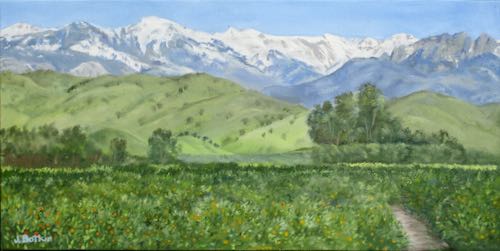
And here is what I need to paint, title, scan, and deliver DRY in time for the event:
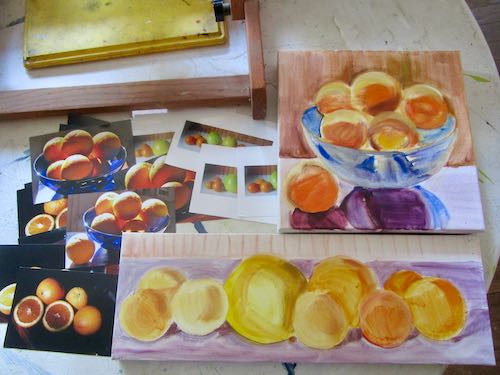
This is a 10×10″ and a 6×18″, both a little different from my regular orange still-life paintings. Those regular ones sell steadily, but I bet most of the attendees to the banquet will have seen, bought, or received one of these already.
